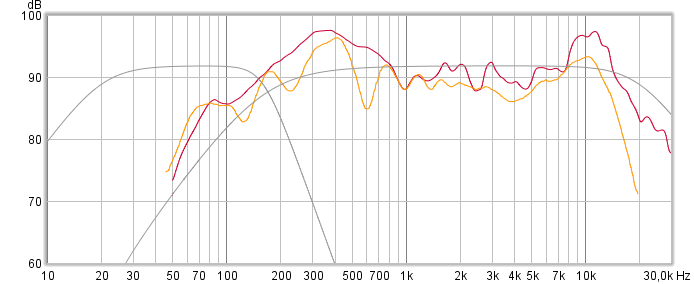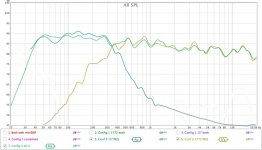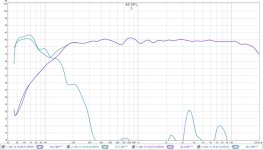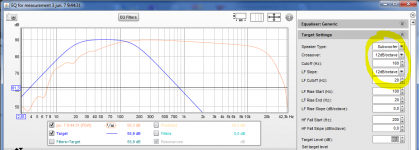Juhazi, I have 1.65ms delay on the 1771, which at 300Hz XO point is half the period, as it is prescribed with the Harsch XO. I could try to change the delay to find how it will affect the response.
That is a theoretical number. In the end it's the real delay that counts, with the mic set at tweeter height the path from mic to the woofer is longer than from mic to tweeter
Try settings like this:

Except choose smaller numbers for span before/after peak to zoom in. Say 10 and 40...
Last edited:
I haven't tried brutal LR8. I'll stick to try making the Harsch workout well, then move to something else to compare.
Juhazi, I have 1.65ms delay on the 1771, which at 300Hz XO point is half the period, as it is prescribed with the Harsch XO. I could try to change the delay to find how it will affect the response.
Yep, it is about fine-tuning delays. But you have really poor summation/attenuation despite slopes look symmetric. First switch polarity of either to see what happens, then start adjusting delay so that relative difference changes +/- 0.2ms per trial/measurement - make a series of 3-5 changes/measurements and then start tinkering! Reflections in the room make this very difficult...
I'm sorry, I forgot to mention it .. well, I did a little. 
The rising of the woofer below 90Hz is not there, and the 80dB at 25Hz from the 1772 is obviously not there in real life.
I'm having huge issues with the sound card. Just chant with me... " Never again with Presonus".
It should actually look like this, there was not output from the woofer over 3kHz, and nothing from the 1772 under 100Hz. I was close to the speakers and can say, those peaks were not there.
The rising of the woofer below 90Hz is not there, and the 80dB at 25Hz from the 1772 is obviously not there in real life.
I'm having huge issues with the sound card. Just chant with me... " Never again with Presonus".
It should actually look like this, there was not output from the woofer over 3kHz, and nothing from the 1772 under 100Hz. I was close to the speakers and can say, those peaks were not there.
Attachments
The slopes I got in my system (see post 448) is only made with PEGs in rephase - The monotonic high or low shelf filters seems to work very well.
Have not experienced much - But with for instance the minimal phase filters in Rephase, the phase is messed up.
A good way to start making the curve is to start the EQ'ing way above the crossoverpoint. Then work your way down.
Have not experienced much - But with for instance the minimal phase filters in Rephase, the phase is messed up.
A good way to start making the curve is to start the EQ'ing way above the crossoverpoint. Then work your way down.
I saw this thread open once again and remembered that I translated the Harsch PowerPoint presentation into English some time back. Perhaps others might like it in English as well (although I always find it interesting how different languages actually present their colloquialisms and select their actual words). Attached below.
Thanks a lot
Yep, it is about fine-tuning delays. But you have really poor summation/attenuation despite slopes look symmetric. First switch polarity of either to see what happens, then start adjusting delay so that relative difference changes +/- 0.2ms per trial/measurement - make a series of 3-5 changes/measurements and then start tinkering! Reflections in the room make this very difficult...
I tried to switch the polarity on the 1772, and I got a deeper dip at XO.
I do think playing with the delay should help in this case.
Indeed, a lot of reflections, especially dealing with OB and a concrete house!
As soon as I have some free quiet time again.
That is a theoretical number. In the end it's the real delay that counts, with the mic set at tweeter height the path from mic to the woofer is longer than from mic to tweeter. You could look at the (new) wavelet in REW to see the time matching at the crossover. It works much like APL_TDA.
Try settings like this:

Except choose smaller numbers for span before/after peak to zoom in. Say 10 and 40...
I wish I had pretty graphs like yours.
Actually, the woofer is at ear/mic level. And it's taken at the listening position.
Do you use a minimum phase impulse to generate this spectrogram of just the raw measurements?
Can slopes higher than 4th order be made to work in any way for quasi linear phase?
We exercised with three way pages back and also tried reverse slope rule and don't think it works very good in my eyes, that said figure out complicated math is really not me so probably I'm not the right to ask.
Any thing will probably sum and sound fine for some somewhere in space whatever slopes and time tricks used but think to get smooth predicted response and coherence in phase plus less uneven dispersion LR is hard to beat and they can be run with DSP linear phase at the cost of some overall system delay for DSP to flatten phase.
@Perceval
Great Harsch exercise and agree 2 hours will flew away and call for more.
Regarding timing keep an eye if we succeeds for mkane77g setup down the road, hope is to get acoustic timing right by first set acoustic slopes as LR4 because they reveal their quality response with one in reverse polarity where they shall be no less than -30dB and more is best of a clean deep null as can be seen over T. Graversen site where with passive XO he makes fantastic deep nulls to get within 1 cycle or so on design axis, then transfer the known LR4 acoustic slopes back to BW4 and BS4 in miniDSP electric domain and add calculated Harsch delay for tweeter to whatever numbers was set in LR4 calibration.
Great Harsch exercise and agree 2 hours will flew away and call for more.
Regarding timing keep an eye if we succeeds for mkane77g setup down the road, hope is to get acoustic timing right by first set acoustic slopes as LR4 because they reveal their quality response with one in reverse polarity where they shall be no less than -30dB and more is best of a clean deep null as can be seen over T. Graversen site where with passive XO he makes fantastic deep nulls to get within 1 cycle or so on design axis, then transfer the known LR4 acoustic slopes back to BW4 and BS4 in miniDSP electric domain and add calculated Harsch delay for tweeter to whatever numbers was set in LR4 calibration.
Byrtt, you lost me at "Regarding..."
Ha ha!
but I have to agree... time flies when dealing with this kind of thing. I sometimes wish I had all day to play with this!
PS. I don't want to take away from mkane's experimentations. Keep at it. Follow these guys. They are very good people.
Ha ha!
but I have to agree... time flies when dealing with this kind of thing. I sometimes wish I had all day to play with this!
PS. I don't want to take away from mkane's experimentations. Keep at it. Follow these guys. They are very good people.
Last edited:
BYRTT where to next?
I have some work to do around me but i keep an eye here also from time to time.
Would it be good you start exercise get the right target slopes into current REW session and align them and save session as described some posts back.
Predict some fine tuning of mid-tweeters LR4 slope around its corner roll off and downward slope but lets see about that when we later comes to the reverse polarity procedure, so after above is fixed then start measure woofer pass band and massage it to look like LP LR4 target curve, in we now low in frq area maybe use FDW window set to no more than 1/6 or temporary make previews in 1/4 and 1/2 to quality check 1/6 is not a too rippled correction.
Last edited:
@Mkane77g
IF its auto EQ in REW you mean then try use as below settings because a low pass BW2+BW2=LR4 so if you EQ to that BW2 acoustic target all we need to do is over in miniDSP is add a electric BW2 and we there. If you have trouble get woofer to stretch its area up so high in frq then set field number two "Crossover:" to 24db/octave and i can come up with a PEQ or two that transfer BW4 to LR4, and actual this is maybe not bad because BW4 is our target later on down the road.
@Perceval, sleep well so you not harsch in the morning : )
IF its auto EQ in REW you mean then try use as below settings because a low pass BW2+BW2=LR4 so if you EQ to that BW2 acoustic target all we need to do is over in miniDSP is add a electric BW2 and we there. If you have trouble get woofer to stretch its area up so high in frq then set field number two "Crossover:" to 24db/octave and i can come up with a PEQ or two that transfer BW4 to LR4, and actual this is maybe not bad because BW4 is our target later on down the road.
@Perceval, sleep well so you not harsch in the morning : )
Attachments
Last edited:
Do you use a minimum phase impulse to generate this spectrogram of just the raw measurements?
Nope, this is the result of a REW sweep of the left and right channel simultaneously at the listening spot after DSP correction.
There wouldn't be a whole lot of difference if I took a minimum phase version of the impulse. For all practical purposes it would look almost identical.
This would not have been possible without damping panels, but you guys, measuring up close should mind the reflections you get. To get the crossover right you have to keep the reflections out of the measured signal.
Place speaker in the middle of the room, same for the microphone, remove clutter around it and use 6 cycles of frequency dependent windows. If needed, place something absorbent between the mic and speaker position on the floor. You have to avoid the reflections to get a useful crossover.
I see way too many peaks and dips in these graphs...
@wesayso
Thanks advises for measurements, from beginning its not worlds smoothest and maybe not a wish in this SLOB system, guess that is up to owners how much time offered to smooth it out in precision style of Barleywater, intend focus to get XO region acceptable for this exercise, below red trace is manufactures response times OB simulation in Edge and orange is what mkane77g had pages back.

Thanks advises for measurements, from beginning its not worlds smoothest and maybe not a wish in this SLOB system, guess that is up to owners how much time offered to smooth it out in precision style of Barleywater, intend focus to get XO region acceptable for this exercise, below red trace is manufactures response times OB simulation in Edge and orange is what mkane77g had pages back.
Last edited:
- Home
- Loudspeakers
- Multi-Way
- S. Harsch XO


